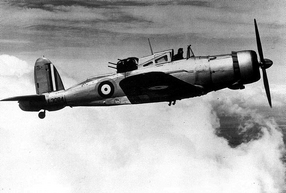The Blackburn B-25 Roc was a naval fighter used by Great Britain during World War II.
Description
Based on the airframe of the Blackburn B-24 Skua, 136 examples were built to specification O.30/35. [N 1]
One of its main differences from the Skua was that it had four .303 Browning M1919 MGs mounted in a turret to the rear, making it the first naval aircraft to be fitted with a powered gun turret.[1]
Variants
Some of the converted aircraft were seaplanes with floats from Blackburn Shark aircraft, while the 28th example - L3084 - was used as a testbed for the sleeve-valve engine.[2] However, the first floatplane version crashed in testing and the floats were very unstable. Only two other floatplane examples were produced. The maximum speed of the Roc with the floats was reduced to only 286 km/h.
History

A Roc in flight.
The Blackburn Roc was first developed in 1938, making it's maiden flight on 23 December 1938.[3] The type was actually built by Boulton & Paul.[4] Trials revealed that the turret penalised the Roc in comparison to the Skua.[3]
Following familiarisation visits to several units of the Fleet Air Arm, the type entered full service when four aircraft joined the eight Skuas assigned to 806 Squadron in February 1940. Four months later six Rocs were assigned to 801 Squadron, with a further sixteen joined No. 2 Anti Aircraft Co-operation unit.
Following a Junkers Ju-87 raid against Gosport, four damaged Rocs were used as machine gun posts.[3]
The Roc saw very little combat before being taken out of front line service, after which it was used as a tug aircraft and a trainer. Although some aircraft were given to second-line squadrons.[5] The B-25 only had one confirmed air victory throughout the war. Some of the places that the Roc is known to have flown is off the coast of Norway and during the evacuation from Dunkirk.
Notes
- ↑ Its name originated from the Roc, a legendary (and mythical) bird that killed and consumed large animals such as fully grown elephants.
References
- ↑ Nijboer, Donald. Gunner - An illustrated history of World War II Aircraft turrets and gun positions. Airlife Publishing. 2001. ISBN 1-84037-304-0
- ↑ Gunston, Bill. Illustrated Directory of Fighting Aircraft of World War II. Salamander Books. 1988. ISBN 0-86101-390-5 Pages 20-21
- ↑ 3.0 3.1 3.2 World Aircraft Information Files Aviation Partwork. Midsummer Books Ltd. File 890 Card 23 (A-Z of Aircraft: Blackburn B-9 to Blackburn B-25 Roc)
- ↑ Robertson, Bruce. British Military Aircraft Serials 1912-1966. Ian Allen Ltd. 1967 Page 109
- ↑ Roc entry on WW II Vehicles]
| |||||||||||
